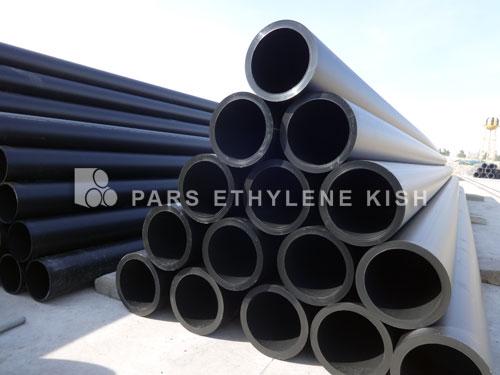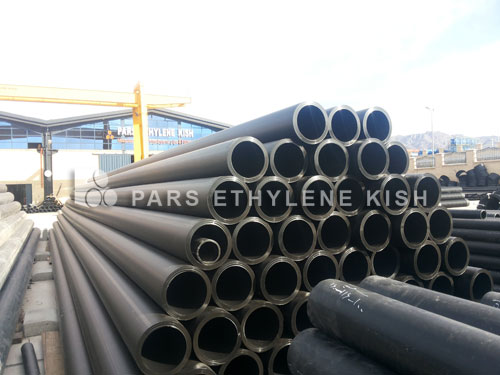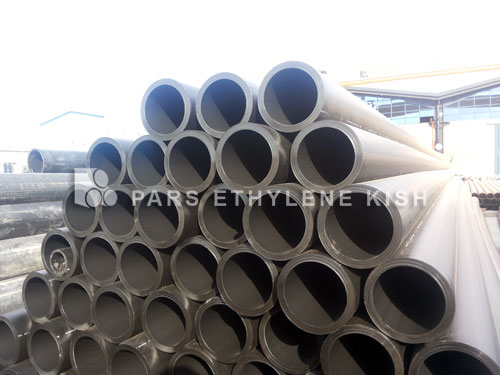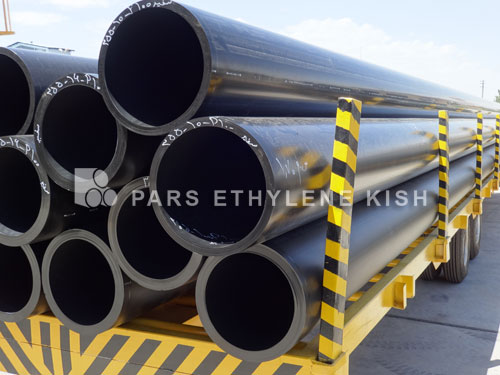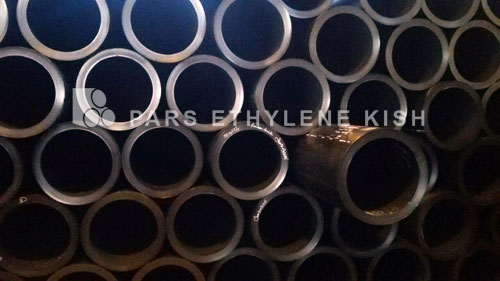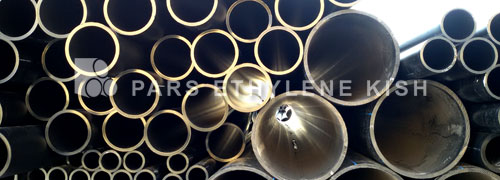
What is the HDPE pipe?
HDPE pipe full form
HDPE Pipe is simply a pipe made of polyethylene; this material gives the pipes some special features which creates benefits and these advantages have led to the popularity of polyethylene pipes.
HDPE Pipes have many advantages, high quality, reliability of pipe and fittings, ease of loading and transportation of pipes and fittings of polyethylene due to their relatively low weight, quick and easy installation have made polyethylene types the best choice for various projects.
Polyethylene Pipe s also have a good bending radius and have very good resistance to impact and pressure at very low temperatures. Acidic and basic environments, as well as many solutions and chemicals do not affect polyethylene. This is one of the most important advantages of a polyethylene pipe and polyethylene fittings.
Polyethylene materials used to produce polyethylene pipes are different from polyethylene materials used to produce other polyethylene products. Polyethylene is available in various grades, and each of these types of polyethylene materials is used for various applications.
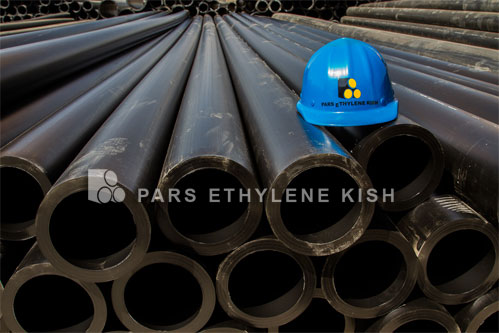
Features of the polyethylene pipe
- Low weight
Polyethylene Pipe and HDPE Pipe Fittings have a lower weight than other types of pipes, such as steel pipes and concrete pipes, which makes them easy to carry, load, and install. Resistance to very low temperatures, strength and durability of compressive stress and tension stress and high elasticity of polyethylene allow the user to carry and install polyethylene pipes for the implementation of various industrial projects.
- Impact resistant
Extremely high resistance of polyethylene pipes to impact eliminates the need for higher pipe pressures and polyethylene fittings and the purchase of anti-shock equipment. This feature makes the implementation very easy and sharply reduces the costs of implementation in large industrial projects, while minimizing waste to zero. This can be a very good reason for replacing pipes and polyethylene fittings with a variety of concrete and steel pipes.
- Erosion resistant
Comparison between PE and other materials has shown that the pipes and fittings made of PE are highly resistant against erosion which makes them a perfect choice for transferring fluids with non-soluble solids, plus they are safe from harms of rodents due to high rigidity of their surface. In addition, rodents cannot damage the polyethylene pipe and fittings, because the very high level of polyethylene pipe and fittings can exclude any damage from rodents.
- Chemical resistant
One of the advantages of note for PE pipes and PE fittings is that they are not affected of acidic and basic chemical environments. You can find the complete list of non-affective chemicals on PE pipes & PE fittings through the standards of pipes and fittings.
- High flow rate
Since the inner wall of PE pipes and fittings are smooth with very low roughness therefore fluids can have a rapid flow within them which is due to the roughness coefficient of 0.007.
- Easy connecting
HDPE pipes are presented in both shapes of coil and branch. PE coil pipes which lead to cost savings are available in different small sizes. Branches of PE pipes can be connected to each other in different ways. Parsethylene Kish provides a vast range of fittings and connections which are easily implemented and covers a professional network of pipeline.
- Flexibility
HDPE pipes have a suitable bending radius, and this makes it easy to install polyethylene pipes and require fewer fittings. The permissible bending radius of the polyethylene pipe is 20 times larger than the outer diameter of it. Due to their high flexibility, polyethylene pipes are the ideal solution for solving many of the issues and problems of installation and implementation, and thus installation and implementation becomes much faster and cheaper.
- Various polyethylene fittings
Polyethylene pipelines require polyethylene fittings and connections in different projects, which will vary according to the type of project. The dimensions and size of the polyethylene welding joints can be manufactured according to customer's requirements, and also their use in sewage, chemical, acid and oil and water supply and pressurized water line is very cost effective compared to steel and iron joints.
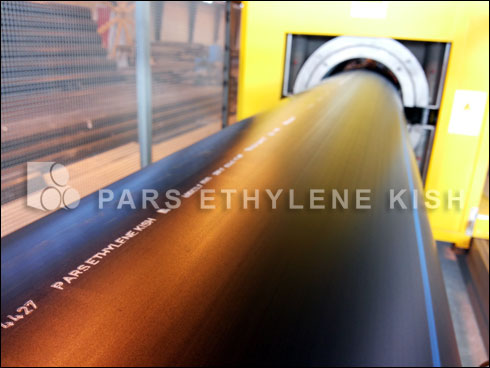
Various types of polyethylene pipes
Single-wall polyethylene pipe
Single-wall polyethylene pipe is among the polymer pipes which can be used at pressures between 2 and 40 bars, with different diameters. The unique properties of polyethylene pipes have led to a much higher rate of growth of use of this product in the transmission and distribution networks compared to other types of pipes.
Double wall corrugated polyethylene pipe
Double-wall polyethylene pipes or corrugated polyethylene pipe are pipes that have two walls; one outer layer with a corrugated or circular shape (ring shape), and one inner layer of the pipe having a smooth surface that is used to flow fluids with acid and sewage effluents and industrial and basic effluents. Corrugated pipes do not have internal load pressure, i.e. the fluid passing through these pipes does not have internal load pressure, and these pipes virtually have the responsibility of transferring fluid as an underground channel. These pipes also have an outer surface which is ring-shaped and has high strength and tolerates all surface and sub-surface pressures, both live and dead, below the ground. The ring-shape nature of these pipes is for strengthening the pipe.
Spiral polyethylene pipe
Spiral polyethylene pipe are the same corrugated pipes with the difference that in the production of spiral corrugated pipes the method of production varies a bit, which is due to the type of size of the spiral corrugated pipes, which generally range from 800 to 3000 mm. Spiral corrugated pipes are connected together using butt weld or extrusion attachment and also have high strength. The working pressure, or cyclic pressure, in the spiral corrugated pipes can be 16 kN, 31.5 kN, and 64 kN, which is directly related to the thickness of the congresses and the outer wall pipes of corrugated pipes’ walls. In addition, the distance between the congresses of spiral- corrugated pipes is also influenced by the convectional pressure of the corrugated pipes. Spiral- corrugated pipes can be produced in a dimension of 6 meters in length and up to 3000 mm in diameter, equal to 3-meter net length of the opening.
Application of polyethylene pipes
The use of polyethylene pipes is extremely high due to their many advantages, and every day we see a new application for the polyethylene pipe, which is often innovative and unique, and in many applications of the polyethylene pipe, this pipe has become an alternative for other types of pipes. High density polyethylene (HDPE) pipes are used in a wide area of urban, industrial, marine, drilling and agricultural pipelines. The use of polyethylene pipes has been tested and proved in situations such as ground level, buried state, floating situation, and sub-surface levels. Polyethylene pipes have the capacity to transport drinking water, sewage, chemicals, slurries, and hazardous wastes and gases.

Application of HDPE pipes
Application of HDPE pipes is extremely high due to their many advantages, and every day we see a new application for the polyethylene pipe, which is often innovative and unique, and in many applications of the polyethylene pipe, this pipe has become an alternative for other types of pipes. High density polyethylene (HDPE) pipes are used in a wide area of urban, industrial, marine, drilling and agricultural pipelines. The use of polyethylene pipes has been tested and proved in situations such as ground level, buried state, floating situation, and sub-surface levels. Polyethylene pipes have the capacity to transport drinking water, sewage, chemicals, slurries, and hazardous wastes and gases.
Uses of polyethylene pipes:
- Urban and rural water supply networks
- Urban and rural sewage networks
- Gas supply networks
- Drainage networks
- Industrial Liquid and Sewage Systems
- Irrigation systems under pressure (drip and rainfall irrigation)
- Movable irrigation systems
- Covering telecommunication cables and fiber optics
- Covering Power Cables
- Covering metal pipes
- As ventilation ducts
- Dredging systems
- Transfer of chemical fluids and industrial products (according to standard)
Grade of Polyethylene Pipe Material
In general, the benefits of using PE100 material compared to other types can be summarized as follows:
- Better processability and higher output and lower production costs
- Better flexibility for screwing, maintenance and installation of the ISO 13469 pipe,
- High resistance to slow crack growth and high product safety (SCG test)
- A higher resistance to the rapid crack growth Test of ISO13469, Version 1996
- High hydrostatic resistance of PE100 compared to PE 80 (test according to ISO 1167)
